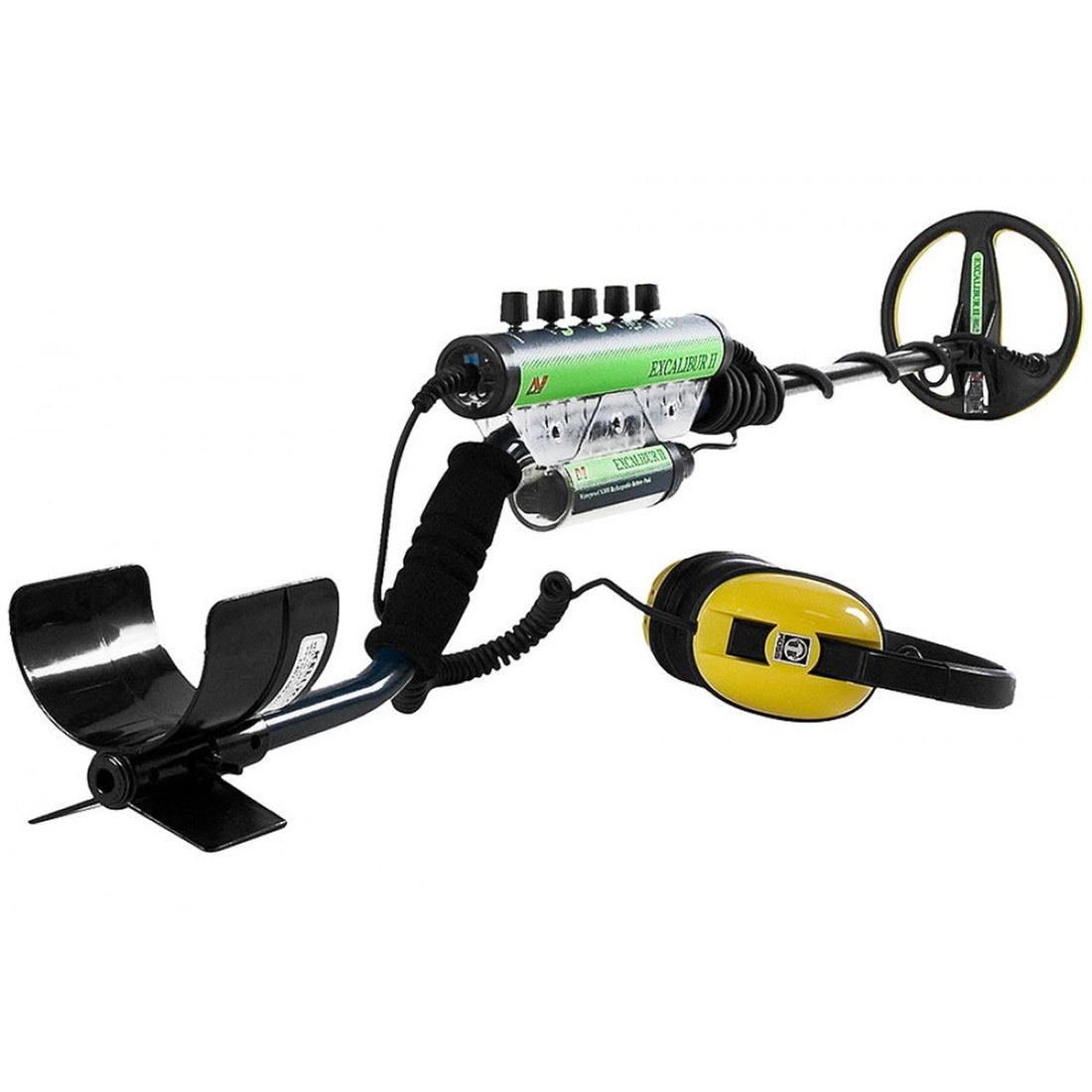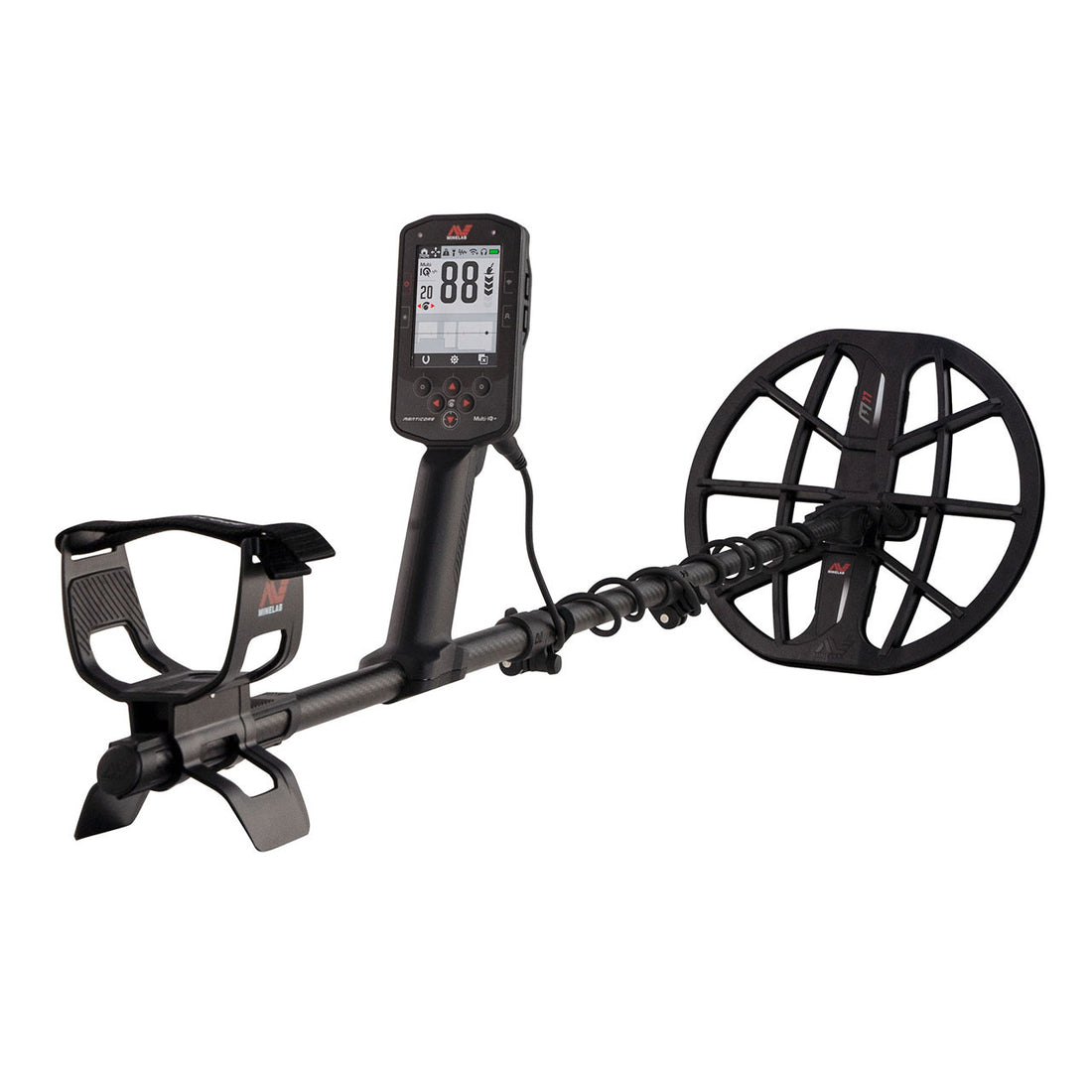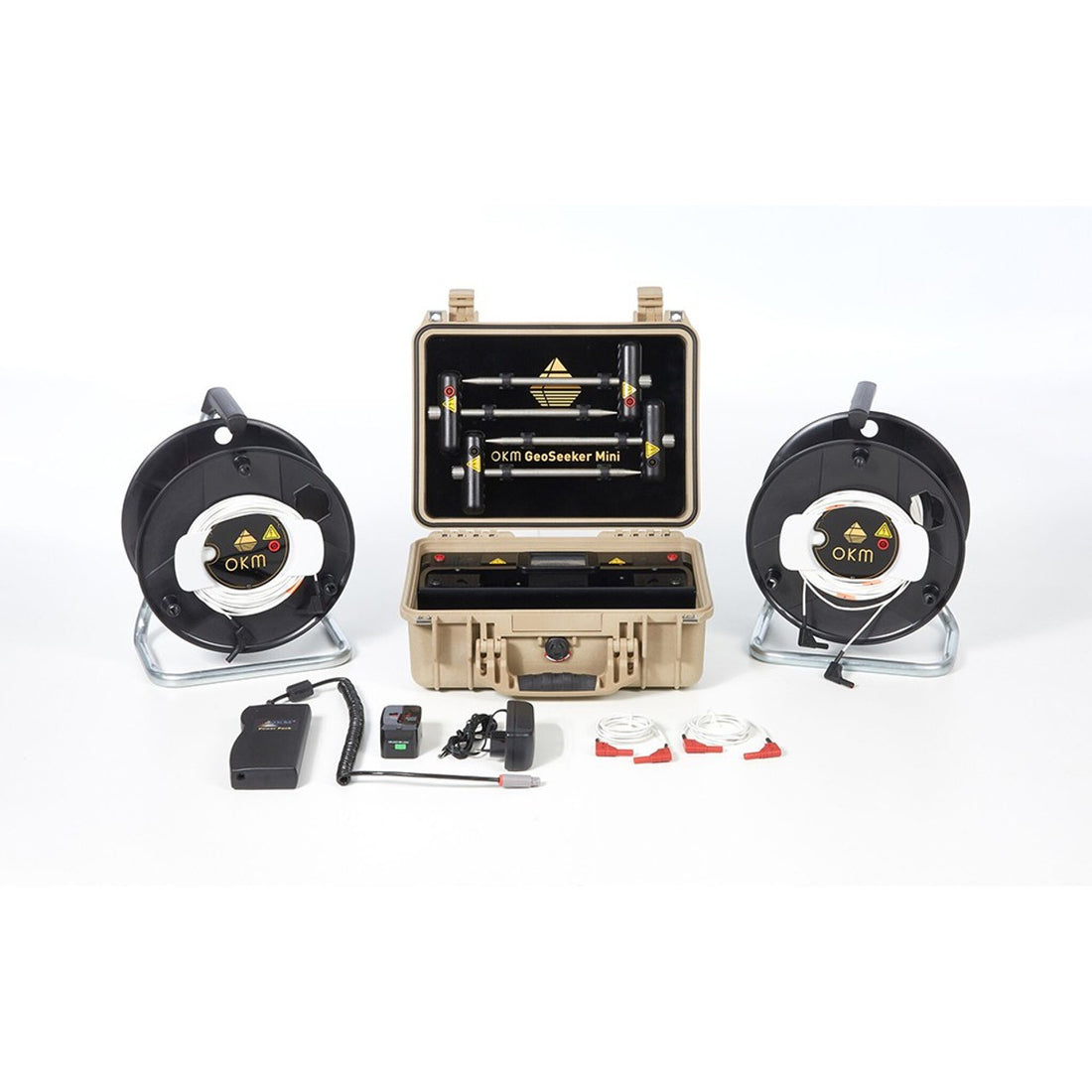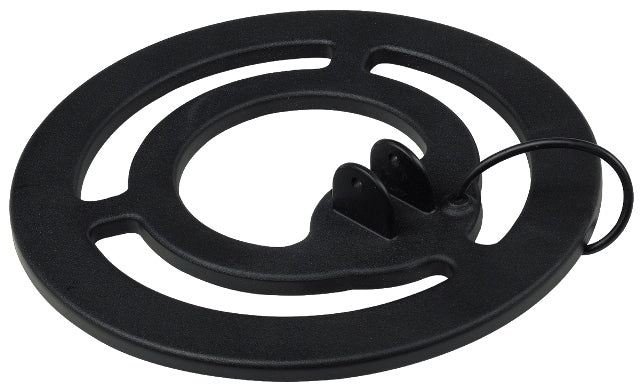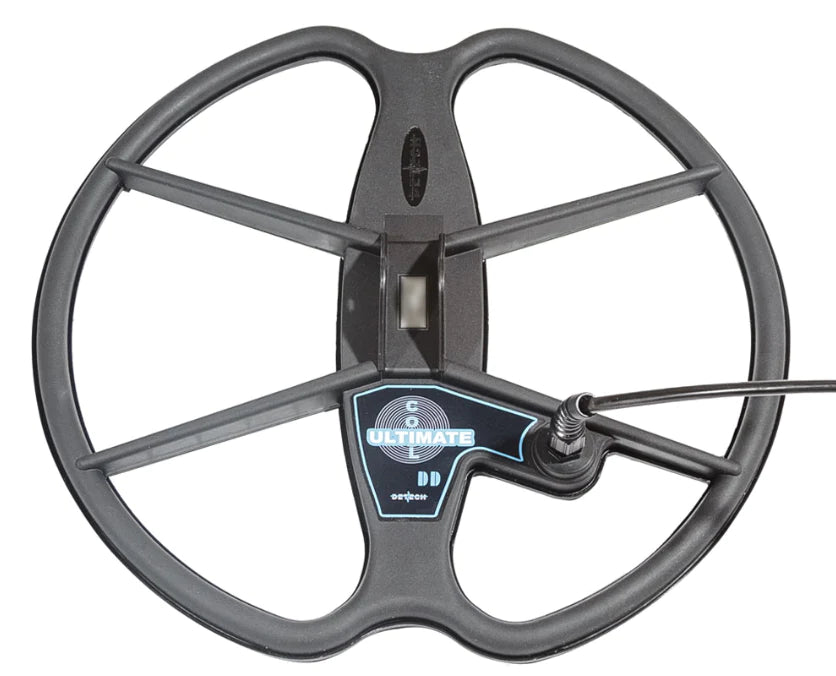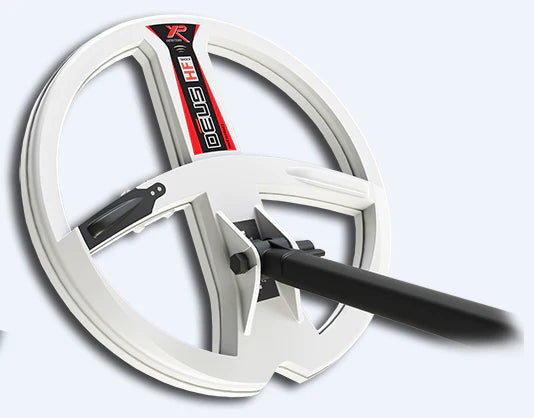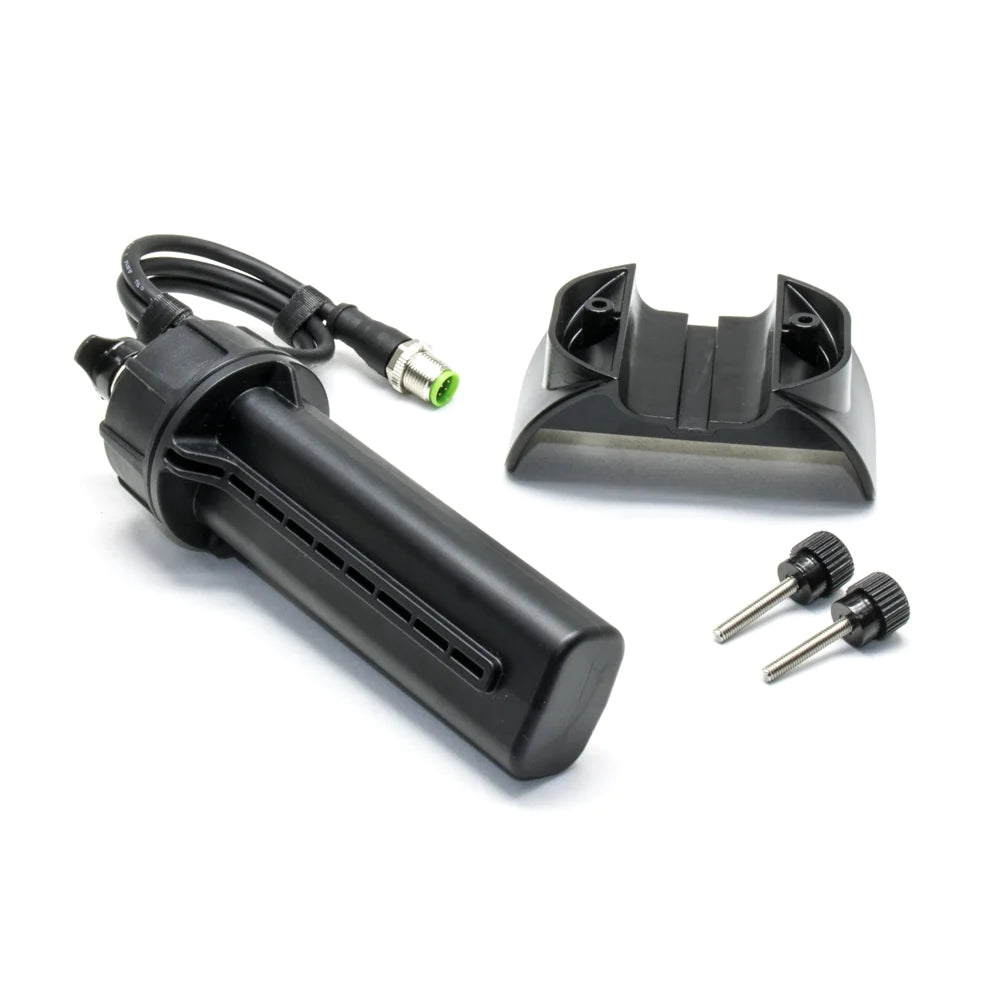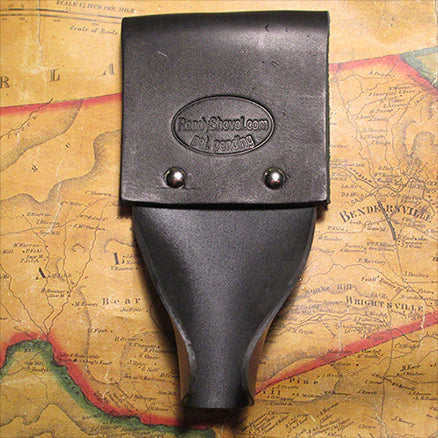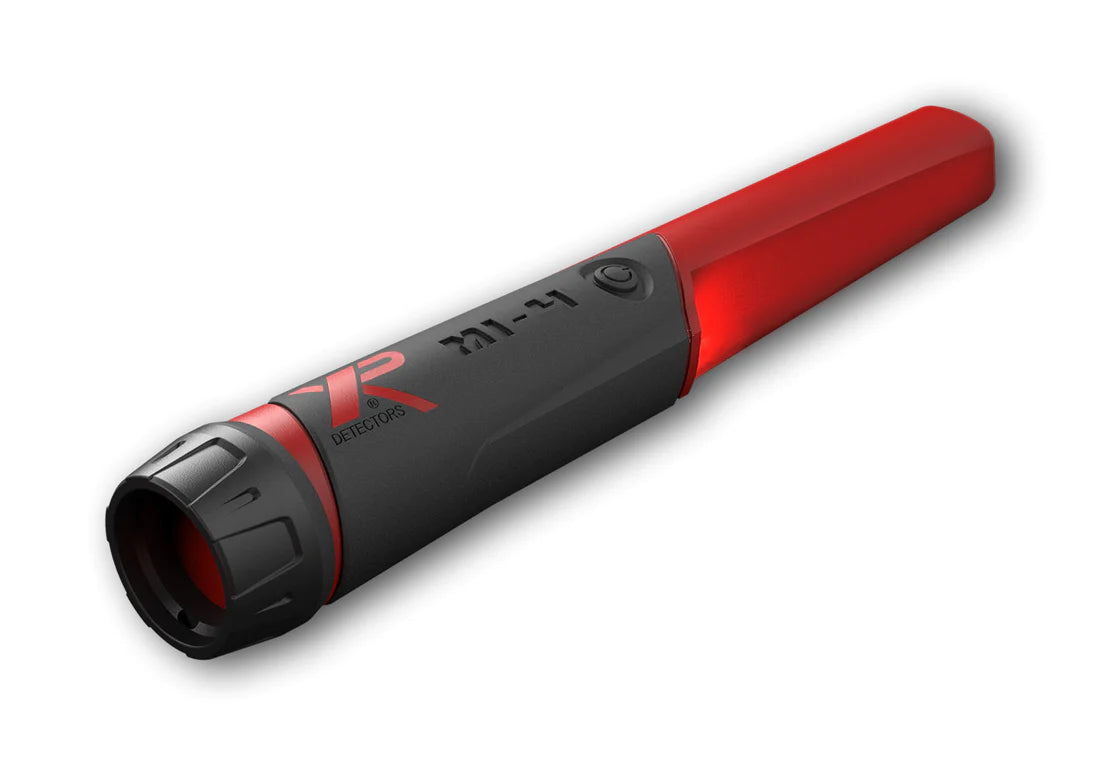Testing The Fisher Lab's F75
Testing The Fisher Lab's F75

Click here to purchase the Fisher F75
Like many other detectorists, I was concerned when discovering that Fisher Labs had been acquired by First Texas. We all know what can happen to the products of companies that expand or become part of another entity. However, the F75 is proving that the coming together of great minds can also usher in better products. After two successful outings with the F75, I was convinced of its merit, and each additional trip built my confidence in Fisher under First Texas. A tip of the hat to lead engineers David Johnson, John Gardiner and their associates for a well thought-out, high performance metal detector. The F75 definitely deserves your attention.
Controls & Modes
For the best understanding of the controls, let's start with a quick overall view. Reading about the controls can be a bit baffling at first. Therefore, I've developed the accompanying chart to provide a quick “snapshot.” You will notice that there are only four external controls, operating in conjunction with the menu-driven controls seen in the LCD. This ingenious concept allows the detectorist to make rapid adjustments, without diving into layers of programming throughout three modes of operation (Motion Discrimination, Motion All-Metal, and non-motion Static All-Metal).
External Controls
- On/Off/Volume (Rotary knob on arm rest.)
- Trigger (Under control box - Pinpoint, FASTGRAB GB, frequency change w/ Menu.)
- Menu (Red housing button - Menu select, recall last setting, freq. change w/ Trigger)
- Settings (Rotary knob on housing face - Select Operating modes, Adjust settings)
- LCD - Menu Controls
Discriminate
- Sensitivity
- Discrimination
- Notch
- # of Tones
- Process #
All-Metal Static
- Threshold
- Audio Pitch
- Sensitivity
- Manual Ground Balance
All-Metal Motion
- Threshold
- Audio Pitch
- Sensitivity
- Manual Ground Balance
As seen above, the three operating modes have their own controls, with five in Discriminate and four in the All-Metal modes. However, in the detector's LCD, rather than displaying three separate columns, engineers cleverly combined the two All-Metal modes into the same control column. Pressing the MENU button highlights (darkens) the top line, and turning the SETTINGS knob allows one to bounce back and forth between Discriminate and All-Metal.
On the All-Metal side of the screen, another press of the MENU button drops the highlight to the next line to choose either Static (non-motion) or Motion All-Metal. The SETTINGS knob permits the choice between these two modes. Continual MENU pressing scrolls through the rest of the controls (Threshold, audio Pitch, Sensitivity, and Manual Ground Balance). As each control is accessed, it is highlighted. Once a control has been accessed, the SETTINGS knob is rotated to adjust it. The word “SETTING” and the control's value numbers appear in the middle of the screen. After the last control, the detector recycles through the All-Metal column each time the MENU button is pressed.
Back on the top Mode line, turning the SETTINGS knob counterclockwise jumps access across to the Discriminate Mode column at the left of the screen. Discriminate is now highlighted and, as in the All-Metal Mode, pressing the MENU button cycles through the controls (Sensitivity, Discrimination, Notch, # Tones, and Process #). As each control is accessed, rotating the SETTINGS knob makes the adjustments. Be aware that the detector will “time out” if no change is made within seven seconds. Conversely, if the MENU pad is pushed from the hunting mode, it will return to the last control setting used (allowing quick access to a control needing repeated changes). The absence of sub-layers of controls to wade through means more time hunting and less fiddling with controls. Further control explanations are provided below. Explaining them takes much longer than the few seconds to adjust them.
On/Off/Volume - This rotary knob on the left side of the armrest obviously turns the detector on and off. Turn it fully clockwise to set the volume to maximum. Sensitivity and interference are not affected by this control.
Trigger - This switch is found just beneath the control box where one's index finger can squeeze it. Pulling it activates the non-motion Pinpoint for precise target location. Pushing activates the FASTGRAB feature for automatic ground balance. The Trigger is used with the MENU button to change the operating Frequency.
Menu Button - The red MENU button on the housing face is used in selecting modes, controls, and last function recall. Its role in changing operating frequency will be detailed later.
Settings Knob - Located on the left of the housing face, this rotary knob works in association with the MENU button. Both are within easy finger reach. As the MENU button highlights a mode or control, rotating the SETTINGS knob clockwise or counterclockwise chooses a mode or changes the value of a control.
Keep in mind that the detector “times out” if no changes have been made within seven seconds, deactivating the SETTINGS knob. Therefore, be certain that the chosen control is highlighted when making adjustments. If not, repeated pushing of the MENU button will cycle through the controls again to make the desired adjustments.
Motion All-Metal Mode More sensitive than Discriminate, Motion All Metal is a self-adjusting threshold mode that will locate all metal targets within its range. Unlike the Static All-Metal, and as its name implies, when this mode is used the coil must be in motion in order to detect targets. Located on the right side of the display screen, Motion All-Metal has four controls:
Threshold - Also called the background tone. Most people like a just audible level to hear changes in the audio. Depending upon the Sensitivity level, it can be lowered to run quiet as well. Each number that is seen in the LCD (-9 to +9) represents five steps of finer adjustment.
Audio Pitch - With a default value of “0,” values run from -9 for a lower frequency to +9 at the highest frequency, with finer adjustment within. Not to be confused with the operating frequency, this feature allows for the fact that people vary in the best pitch or audio frequency for their individual hearing.
Sensitivity - One of the most misunderstood controls is the one that regulates the signal gain. Far too many people crank the sensitivity high and then wonder why their detector is “acting up.” Generally speaking, the optimum level of sensitivity is dependent upon the mineralization present, outside electrical interference, and the amount of trash in the ground. The F75's range runs from 1 to 99. Although experienced hunters can get away with tweaking their machine, the old rule of thumb is to set sensitivity as high as possible while maintaining smooth operation (no false signals).
Manual Ground Balance - The manual suggests performing Manual Ground Balance in the Motion All-Metal Mode for a more accurate setting, rather than the Static All-Metal. The setting carries over into all three modes.
Static All-Metal Mode Since this mode shares the same controls as Motion All-Metal, there is no need to go through the controls again. Unlike the other two modes, in Static All-Metal the coil does not have to be moving to maintain a signal. This mode is useful in finding large, deep objects. Also, the Sensitivity for Pinpoint is set in this mode.
With the MENU and SETTINGS controls, Threshold is set with the coil in the air to hear a background hum. The more this hum goes into the silent zone, the less sensitive it is to weaker signals. The Threshold in Static All-Metal Mode does not self adjust. Therefore, when the audio drifts, squeeze and release the Trigger. It is suggested that Sensitivity be set high enough to hear a little background noise for better depth. If you cannot tell the difference between chatter and a target signal, then lower the sensitivity a bit. Before using the Static Mode, be sure to use Fastgrab or perform the manual ground balance in Motion All-Metal. Otherwise, the audio could be either noisy or so quiet that sensitivity is lost.
Discrimination Mode
Most detectorists use this motion mode as it is the one that helps eliminate trash target responses. As with any detector, the more trash that is rejected, the greater the chance of missing good targets within the same target ID range. There are five controls in the Discrimination menu:
Sensitivity - Just as in the other modes, this controls the signal gain. However, there is no connection between the sensitivity of the Discriminate (Silent Search) and All-Metal (Threshold) modes. When Sensitivity is accessed in the Discriminate Mode, it can be adjusted from 1 to 99. Keep the sensitivity at a level that is as high as possible, without losing smooth operation.
Disc Level and Notch - You'll notice that I've included these two trash elimination controls in this same section. That is because they are closely related. Additionally, the top two rows of the LCD can be a little perplexing at first glance and require additional explanation.
Detectorists know that there are many trash targets in the ground along with all those coins, jewelry, and other good items. To save our sanity, we try to dig the good ones and avoid the bad ones as much as possible. Metal detectors identify targets by how well they conduct electricity and assign a value to it (target ID). Fortunately, most U.S. coins and many other items, both good and bad, produce a fairly consistent target ID. In this way, the F75 can eliminate signals from a large amount of trash such as iron nails, foil, aluminum pulltabs. The digital ID number (visual Target ID) of each target is displayed in the center of the display screen for about four seconds, unless replaced by the next target.
The visual and audio target identification systems work independently of each other. Some common IDs are U.S. nickels - 30; pulltabs - 33 to 55; foil - 16 to 25; zinc cents - 60; copper cents and clad dimes - 70; U.S. quarters - 80, etc. The Discrimination control of the F75 adjusts to eliminate responses between 0 and 65 (iron to zinc cents). It stops there to avoid losing higher conductivity targets such as dimes and quarters. Push the MENU button until DISC LEVL is highlighted, then use the Settings knob to adjust. Watch each large ID number in the center of the screen as the Settings knob is turned. If you raise the discrimination and then let the display “time out,” the last viewed number will be the discrimination level. When the desired level is reached, press MENU to accept and view the screen to confirm the level set.
For those new to detecting, Notch is a term best described by the following scenario. We've just set the Disc Level up to and including Tab (0 to 55). That means it is eliminating pulltabs and every metal target ID'ing below that point. It also means that U.S. nickels and jewelry within an ID range of, say, 26 to 30 will also be lost. However, with Notch those particular targets can be detected. Think of Notch as a window punched into that wall of discrimination, to allow the signals of nickels to come beeping through while keeping out nails, foil, pulltabs, etc. In this case, it was nickels and certain gold rings being accepted, while those items around them were rejected. Although other notches are available, this is the simplest and most common use of notch.
Along the top of the screen is a row of numbers (15, 25, 35, 55, 65, 75, 99) and, below them, a row of target words (Iron, Foil, Nickel, Tab, Zinc, Dime, Quarter). The top row numbers are probable target ID ranges that line up with the corresponding target word (category) below it. As targets are detected, a large target ID number is seen in the center of the screen, as well as a darkened rectangle or cursor next to the matching number range on the top row.
Each target category word in the second row is composed of a small range of target ID numbers. As discrimination is raised, darkened cursors appear next to each first-row number range and slash across categories in the second row. This indicates their selection for discrimination. The ID numbers within each target category are blocked into two halves. A slash mark will appear across one half of the category word, and then the other, as discrimination or notches are set. In other words, you don't “notch out” a large block of ID numbers— you do it in halves. Of the seven target word categories, five of them are within the discrimination range (Iron, Foil, Nickel, Tab, and Zinc). Each of them has a first and second half, which means that those five categories, become ten blocks of target ID ranges. The following list details how they are arranged. The ID numbers on the left side of the word represent the first half, and the second half is on the right: 1-7 Iron 8-15/16-20 Foil 21-25/26-30 Nickel 31-35/36-45 Tab, 46-55/56-60 Zinc 61-65. Use them as a guide in setting discrimination and notches.
To set Notch, use the MENU button and SETTINGS knob to choose and adjust the notch the same as other controls. However, with Notch one needs to be aware of the current status of the block of ID numbers being accepted or rejected, as it will reverse what is already seen on the LCD. If a target word does not have a slash in it (accepted ID numbers) and then it is “notched,” it will be rejected with a slash over that part of the category. Conversely, if there is already a slash (rejected ID numbers), the notch action will reverse it, the slash will disappear, and the block of numbers will then be accepted. Keep in mind that a notch of numbers can be either accepted or rejected.
Check the LCD to be sure that it is set the way you want it. Once set, push the MENU button to accept, but be watchful as the circuit then goes to the next control. If that happens, just cycle through the controls back to Notch and make the adjustment. One area of improvement here would be to disarm the time-out feature and continue control access until discrimination and notches have been set. As is, new users will need to pay close attention when setting notches. It does take some practice, but the learning curve is not long.
Number of Tones - This is a great tool to enable one's ears to hear “audio discriminating.” The F75 has the ability to choose audio tones to match the target ID response of metal objects. The detectorist listens for certain pitches to indicate a possibly good or bad target. This discrimination by ear saves the need to constantly look at the screen for visual target ID. Using the MENU button and SETTINGS knob again, there are several choices of tones.
#1 - Single medium-pitched tone (all metals provide the same tone).
1F - tone varies from medium to high, depending upon the signal strength of the target.
2F - Two tones similar to 1F, except that iron emits a low tone regardless of how strong the signal is.
#3 - Three tones. Iron has a low-pitched tone; aluminum trash, zinc cents, and nickels have a medium tone. Higher conductivity coins such as dimes and quarters (and possibly steel bottlecaps) produce a high tone.
3H - Three tones. Same as #3; however, nickels are included in the high tone.
#4 - Four audio tones. Similar to #3, except that the range from 53 to 65 has its own special medium-high tone. (Thomas Dankowski noticed that older coins often registered in this zone when he was helping to develop Fisher's CZ-3D).
4H - Same as #4, except that the high tone is accorded to nickels as well as high coins. dP (Delta Pitch). Provides pitches to match the target ID. The higher the conductivity, the higher the tone. Also useful in identifying steel bottlecaps, which produce an inconsistent tone, often with a squawk starting the sound.
Process Number - Fisher calls these Process Numbers, in that they differ by how signals are processed for analysis. I think of them as programs to match the search conditions encountered. Experimenting with them can offer more options in dealing with gain or sensitivity.
dE (Default) - This default process is the one when first using the F75. It works quite well in most situations and provides good stability for smooth operation.
JE (Jewelry Process) - This process is more likely to provide false signals or noise due to “hotter” sensitivity. It is more sensitive to lower conductivity targets such as small gold jewelry.
Bc (Bottle Cap) - When steel bottle caps are a problem, this program will cause their signals to be inconsistent, with broken tones and non-repeatable beeps. Separating nearby targets is slightly more difficult in this program.
PF (Plowed Fields) - Varying the matrix below the coil with air and ground can be difficult to handle. This program is helpful in that environment.
Ground Balance
The F75 has two methods of balancing out the effects of ground mineralization: automatic FASTGRAB, and manual ground balance. When some people hear the words ground balance, the hair goes up on the back of their neck. That reaction is not necessary with the F75. FASTGRAB is a snap, and manual ground balance is not difficult. Once done, the setting carries through to all modes. The preset ground balance of 90 should handle most common situations in Discriminate mode. However, performing ground balance is a good idea to be safe. An improper ground balance can affect depth of detection, accurate target identification, and smooth operation.
FASTGRAB is automatic, easy, and fast. Just find an area of soil containing no metal (use Pinpoint). Start with the searchcoil about a foot off the ground, push the Trigger forward, then pump the coil up and down a few times from 6" above the ground to near the surface. Now here is the important part— look at the center of the screen for a two-digit readout of the ground reading. If there is a message in small letters saying the detector “Can't GB,” you need to find out why. The message may be “Overload Raise Coil - Can't GB.” Make sure that you are pumping the coil level with the right timing and coil height and not near a piece of metal. FASTGRAB will not automatically ground balance on highly conductive soils such as wet salt water beaches where Manual Ground Balancing is necessary.
Manual Ground Balancing is not a big deal. Place the detector in the Motion All-Metal mode and select Manual Ground Balance. You will notice that in the LCD it says “G.B. SETTING” and displays a range of numbers from 0 to 99. Yet there are actually 500 possible settings, because each number has a fine-tuning of five steps. You will then obey the LCD message, “PUMP COIL TO G.B.” Pump the coil up and down over clean soil from about 6" to 1". Once or twice a second is the proper amount. The idea is to eliminate the sound (or as closely as possible) as the coil goes up and down by making adjustments with the SETTINGS knob. If the sound gets louder as the coil is raised, increase the setting (clockwise). If you are new to detecting, don't let this manual ground balancing information throw you. All it takes is a little practice and patience.
The two-digit ground balance number that appears in the screen can tell you something about the ground: 0-10 = wet salt or alkali; 5-25 = metallic iron, or the coil is over iron; 26-39 = occasional saltwater beaches; 40-75 = red, yellow, or brown soil contain iron-bearing clay; 75-95 = magnetite and other black iron minerals. If the ground reads less than 40, FASTGRAB will not do, and manual ground balance is necessary.
The FE304 Bar Graph is to the right of the LCD center. It displays the amount of magnetic mineralization. However, the coil must be in motion, as in the ground balancing, coil-pumping process. It runs from blank for white beaches, through 0.01 for light mineralization, to 3 for rare, heavy mineralization. If mineralization is heavy, the All-Metal mode will have better ground penetration than the Discriminate mode, and ground balancing is a must. Use it to handle the encountered soil makeup.
Frequency Shifting may be needed if the detector is acting up while the coil is held still in air, away from metal, and the sensitivity setting is not excessive. In that case, the cause is usually due to interference from another detector or electrical device on the same 13 kHz frequency. The F75 is able to change its operating frequency from a setting of F1 to F7, with F1 being the lowest. Hold the MENU button down while the Trigger is pushed or pulled (push for lower frequency; pull for higher frequency). Then release and push the MENU button to change frequencies. The changes can be seen in the center section of the LCD.
The CONF or Target Confidence Indicator is to the left of the LCD center. The more segments that are darkened, the more confidence the detector has in the digital target ID number shown. Three segments or less means confidence is low, while all six segments is a high confidence value. The best reading comes with the target under the center of the coil in a normal sweep.
The Depth Bar Graph on the left of the screen gives a snapshot of target depth while hunting. Naturally, it is not as accurate as the Pinpoint depth reading. However, it does give one an idea of an item's depth without stopping to pinpoint. Try to sweep the coil center over the target. The readings are Shallow (0-4"), Medium (4-8"), and Deep (over 8").
Pinpointing is achieved when squeezing the Trigger. It finds the exact location of the target and provides the target depth in inches. Since Pinpoint is non-motion All-Metal, the coil does not have to be in motion to hold the target signal. Fisher terms this VCO-type pinpointing Variable Audio Pitch. While squeezing the Trigger, slowly bring the coil side to side, and then front to back over the target. When the sound is loudest and the pitch highest, the target will be under the center of the coil. Check the center section of the LCD for the target depth reading, which is scaled to coin-sized targets. Although the F75 uses a double-D coil, I was amazed to find the pinpointing nearly as accurate as with a concentric coil. To narrow the target further, move the coil just off the target, release the Trigger, and then re-squeeze and hold. Often called detuning, this technique works splendidly. Pinpointing is also a tool to check the ground balance setting. If a clean piece of ground “sounds off” as the coil is lowered with the Trigger squeezed, recheck the ground balance.
Battery condition is shown at all times in the bar graph at the right side of the screen. Alkalines show three bars at full strength, down to no bars with a flashing indicator when they're about to go. Four alkaline batteries will provide about 30 hours, and rechargeables about 25 hours.
The Backlight is always illuminated with a light-emitting diode that has practically no effect on battery life.
Resetting to Factory Preset is quickly done if you think you have made too many confusing changes. The microprocessor of the F75 saves all settings even after the machine is turned off. This is very handy for turn-on-and-go operation, once you have everything set the way you want it. To return to “out of the box” settings, first turn the detector off. Then press and hold the MENU button and push and hold the Trigger forward while turning the detector on. Release the MENU and Trigger controls, and the screen should show the letter “F.” When it disappears, the detector is back in factory-preset condition.
Click here to purchase the Fisher F75
In The Field
The F75 arrived the day before our family was leaving for a quick trip to the New Jersey beaches. I already knew that it is a very sensitive VLF induction balance detector. Therefore, I did not expect it to excel on the saltwater beaches—but I was in for a surprise. Now don't misunderstand. I'm not talking about wading out into the surf, but right along the edge on the wet salted sand, the F75 did a remarkable job. Minor adjustments allowed me to avoid false signals and still get great detection depth. Naturally, on the dry sand I could operate it nearly wide open. Granted, most Southern New Jersey beaches are lightly mineralized. However, wet salt is wet salt, and there were areas of black sand as well.
In this sand-blowing, saltwater environment, I was happy that covers for the control housing and battery box are included with the detector. Although I was not able to get in as much beach hunting as I would have liked, it was enough to learn that the F75 could cut the mustard. Right away, I noticed that the large screen was easy to read. There was no squinting to see target ID numbers or control adjustments. However, ground balance and help messages were tiny.
After ground balancing in the Motion All-Metal mode, I left it there for a while, but hunting in All-Metal did not las long due to a great many small pieces of iron in the beach. My next action was to hunt in the JE process of Discriminate Mode with low discrimination to try for small gold. That may be OK for fresh water, but this mode is just too hot for wet salt sand. Although I could have persisted with lowered sensitivity and higher discrimination settings, instead I decided to try the DE process with high sensitivity and just a bit of discrimination for tiny iron.
The Discriminate Mode, to my great surprise, was outstanding. Sensitivity was raised as high as 80 before false signals became a problem. False signals hit at ID numbers 16, 17, and 18. Running the coil over the surf was registering #16. False signals easily discernable by their non-repeatable, wider beeps. Experimenting with many settings, I found that a slightly lower sensitivity did bring smooth operation without false signals. Of course, up on the dryer sand, hunting in high sensitivity was no problem at all.
Most of the time my favorite settings were very low discrimination and Tone at 3H (iron a low buzz, zinc cents and aluminum a medium tone, and better coins (including nickels) a high tone), Sensitivity just below 80, and dE Process. The F75 was working quite well on the wet salt sand as I pulled dimes from 8" and quarters from 9", and around iron as well. Those pesky beer bottle caps revealed themselves with ID numbers that jumped around and did not lock.
Besides great detector performance, I was amazed that I had been hunting for an hour before I thought of changing arms. That means good ergonomic design for fatiguefree hunting. No gold jewelry was found, but that was not the detector's fault. With the varied amount of items I was scooping up at good depth, if the coil had gone over gold it would have found it.
I took the F75 to a variety of inland locations, including modern parks, old parks, schools, and rustic home sites. Parks are always good sites for testing, because most people buy a detector for coin hunting and need to know how it handles coins among modern trash. Additionally, I was able to use the F75 in a competition hunt.
Parks with large expanses of green grass and sports fields in all directions are a delightful sight to detectorists. The first order of business was to compare ground balance readings. FASTGRAB was quick and easy, and compared closely to the manual ground balance reading in Motion All-Metal. Sensitivity was set at 70, Disc 15, #Tones dP (Delta), and Process #dE. When raising Sensitivity to 90 there was some ground chatter, and yet one can tell the difference from repeatable beeps for targets. When ground chatter did become annoying, lowering Sensitivity to 75 had it running quiet and smooth. Hunting in JE was also possible with the lower sensitivity.
I had thought that I would be hunting mostly in the dP Tone with its multiple target tones. I did like the multi-tone very much; however, a lower tone for a number of ID #21 targets had me thinking that I might tend to ignore the lower tones. Although these turned out to be mower-shredded pieces of aluminum, they could just have easily been good targets such as a small gold ring. Therefore, I ended up using 4H in dE process most of the time, which kept repeatable, lower conductivity tones relevant. It also has that fourth tone for many older coins. Everyone will have his favorites; this tone and process just felt best for me.
Pinpointing was amazingly sharp, and I was able to detune to make it even sharper. Raising the coil an inch over the target narrows it further. After pinpointing I could move the coil to the side, put my finger on the ground where the coil center had been, and find the coin exactly there or within a fraction of an inch. This happened so many times that I never stopped marveling at the pinpointing accuracy of this DD coil. For the most part, both coin depth readings and target ID were very good. There were a few coins that were not quite as deep as indicated; however, this can be due to their being on edge, or not getting the center of the coil over the target.
A few of the targets found were a repeatable #42 ID at 4" (folded over square tab), ID #60 and 61 were most often zinc cents, ID #51 @ 4" were two dime-sized slugs at 5", #73 @ 3" was a button from St. Jane School, Riviera Beach, Maryland, #71 @ 5" was correct as a dime, #71 @ 5" another time was not correct as it was a zinc cent (halo effect, no doubt), #70 was always correct for copper cents, and #60 was always correct for zinc cents. Target separation for picking coins from trash and iron was very good.
The F75 is able to process ground matrix info very quickly with a very fast recovery speed to identify individual targets, plus has a good see-through ability around small iron. Any ground noise in bad ground can be eliminated or reduced by setting the ground balance a couple of numbers to the positive. The most accurate target ID came from coil sweeps that were wide and relaxed, instead of short, slow sweeps. A faster sweep seemed to go deeper for grabbing some targets.
One day I was hunting a WWII site with two friends, John Crater and Carl Helm. They both use a non-Fisher brand detector that is a good one. I was using the Fisher F75. We had been detecting for about an hour and found quite a few newer coins but nothing old. John and I stopped to discuss this. While talking, I noticed a rise in the ground on the other side of the field. I had an idea that perhaps the top layer had been bulldozed to one side to level it out, and now it was covered with grass. The little hill ran about 30 yards long, and I started detecting the top. Right away I received a dime signal at 6-7" with a solid beep. It was a Mercury dime from the 1940s.
I called my friends over, and the three of us gave that long hill area a good going over. We found some shallow modern coins. Neither of them got any deep hits, but finally the F75 rang out two more times with the same deeper results, netting me a total of three Mercury dimes. John and Carl are both good hunters, and it wasn't due to luck. Those three dimes were found because the F75 was able to go deep in mineralized ground, give a proper audio and visual target ID at depth, and notify me with a good solid, repeatable beep. There's no doubt in my mind— it was the F75 that made the difference.
A competition hunt came along just as this report was being completed. At the hunt, as at the wet salt beaches, the F75 dispelled my doubts in yet another challenging situation...bit time! I already knew that the 11" double-D could pinpoint like a champ. When the audio was loudest and pitch highest, that coin was right below the center of the coil. I'm not going to tell you that it was as fast as a concentric coil, but nearly so—and that was more than offset by the ground coverage of the 11" coil. I also knew that I could sweep the coil at a good gait, but I was not so sure that the detector would stand up to a real competition hunt where speed means everything.
There were to be two hunts at the Lancaster Research & Recovery Club Hunt in Pennsylvania. I decided to use the F75 in the morning hunt and take my losses for the sake of the field test, then catch up with a concentric coil detector in the second hunt. Was I in for a shock! Both hunts were for silver dimes and quarters, with tokens being painted quarters. If you can find a dime you can certainly find the larger quarter if the coil goes over it. In the first hunt, I was sweeping that coil fast to cover ground rapidly, and without missing targets. The F75 made hit after hit with no doubt about the target. Another shock was the speed at which I could pinpoint under competition conditions. The proof of in the pudding was at the end of the first hunt. My number of silver dimes was just as good as most other people's with competition machines.
When the coins had been cleaned out and folks were just milling around without finding much, I went over to an area that many people had been avoiding. It is loaded with pieces of iron that drive detectors crazy. Pennants are used to mark the area, but there is still deep iron around the perimeter to mask coins. I picked up an extra half dozen silver dimes with the F75... coins that iron had hidden from other detectors. In fact, the F75 did so well that I used it in the second hunt with similar results.
During these events I made several experimental changes with the detector. Control adjustments were accomplished quickly without delaying my hunting. Since the targets were silver coins, discrimination was set at a full 65. Sensitivity was lowered from an initial 70 since seeded targets were shallow. I was picking up deeper targets, too, but didn't have time to dig them. Process dE was used for the entire hunt, and Tones set to hear high tones.
As an afterthought, the realization came that I had changed hands only once during the hunt— another testament to fatigue free hunting. During the lunch break, I was discussing the machine with two friends from the Philadelphia area, Jerry O'Donnell and Dennis Dougherty, and I let them have a go with the F75. They were also surprised at the lightweight feel for a machine that offered so many features.
Summary
Targets find it difficult to escape beneath the broad, fast, and deepseeking sweep of the coil. The innovative 11" double-D searchcoil handles mineralization, separates targets, and pinpoints like a concentric. The more one uses the F75, the more it earns the detectorist's respect. It will do well in coin, relic, prospecting, cache, and even many beach hunting situations. The All-Metal modes, with good control over ground balance and sensitivity, should make it popular with gold prospectors.
The detector has an external speaker, and there is a 1/4" stereo headphone jack at the rear of the armrest. The armrest is fully, and I mean fully, adjustable. The sides can be bent out or in to match arm width, and the rest can be moved back and forth for arm length. The configuration is a three-piece Srod, ergonomic design and lightweight at only 3.5 lbs. with batteries. The spring clips, locking collars, and durably padded handgrip provide a comfortable, no-wobble swing.
It has an abundance of feature adjustability to meet many situations. Three operating modes, straightforward control adjustments with no sub-programming, fingertip controls, deepseeking target ID, and a five-year warranty are a few of the things that allow me to readily recommend the F75 for your consideration.
Click here to purchase the Fisher F75
Reprinted with permission from Western & Eastern Treasures (Copyright January 2008)

